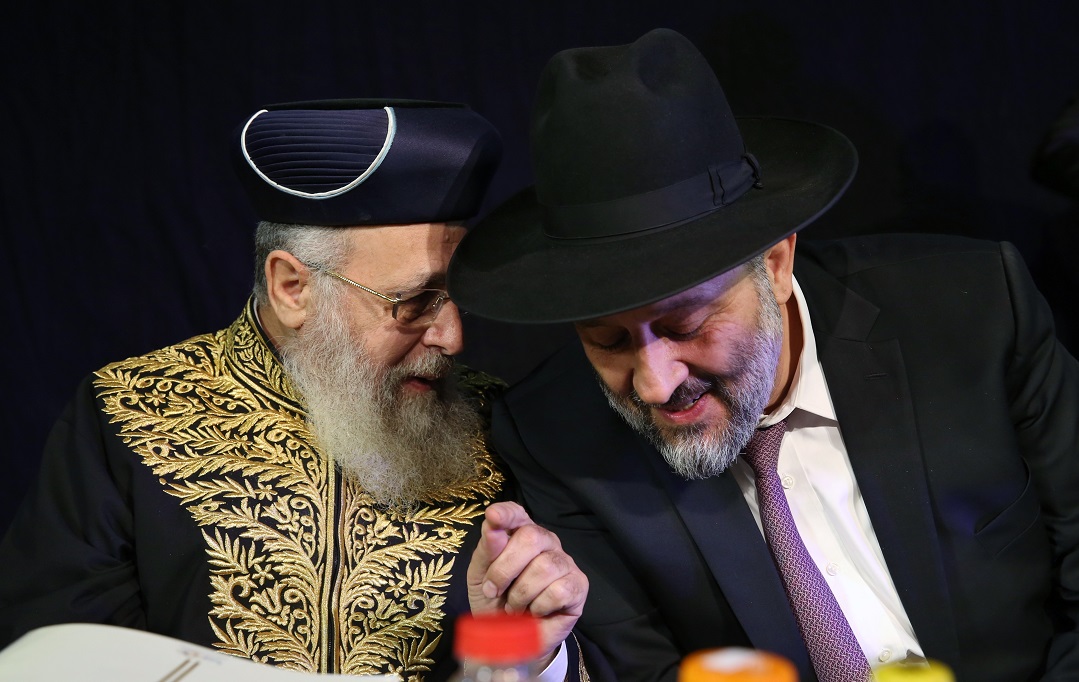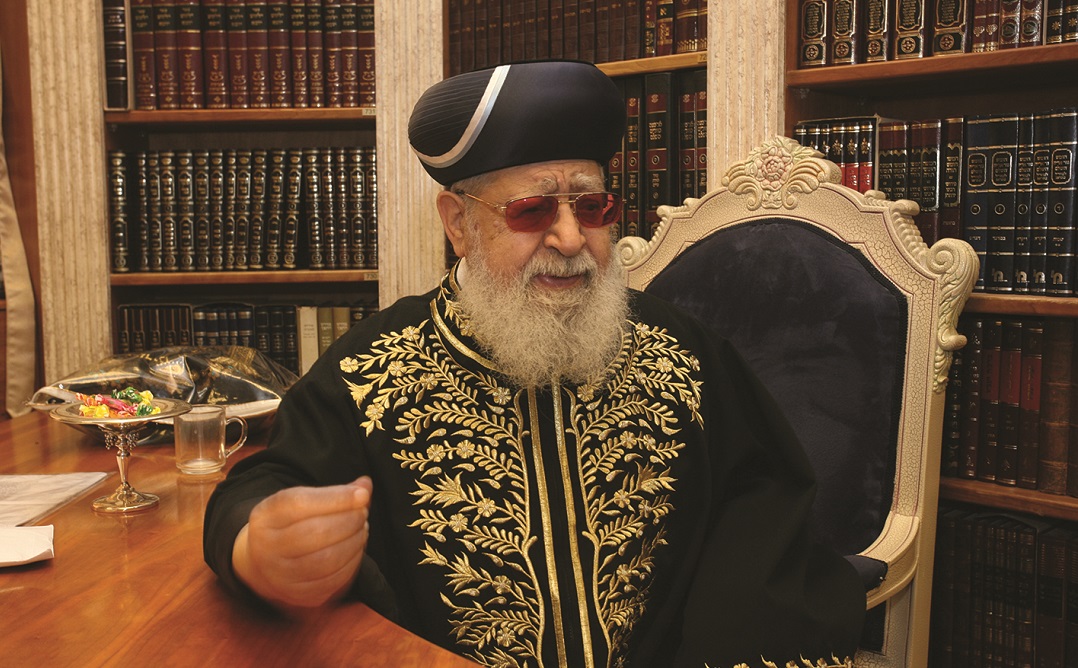Sefarim were his Bread

“These sefarim are my fathers and teachers. When I was very young, I saved penny after penny so that I could purchase them. I went without bread to be able to buy another sefer for my home.”

R
av Ovadiah Yosef’s many sefarim — among them Chazon Ovadiah, Yechaveh Daat. and the ten-volume Yabia Omer — have earned him acclaim both in the Torah world and outside it. Beyond the wealth of Torah in his sefarim, the abundance of sources and citations, and the towering structure of halachic reasoning that is built before the reader’s eyes until the teshuvah reaches its conclusion, studying Rav Ovadiah’s responsa is also a genuine intellectual experience due to his unique style, his turns of phrase, and the occasional forceful approach toward other poskim with whom he does not agree.
But Rav Ovadiah said that his original writing mentors were none other than the first sefarim in his private, treasured collection. “Do you see these sefarim behind me?” he once asked Mishpacha’s Yossi Elituv, as he pointed to the thousands of sefarim that line his room. “These sefarim are my fathers and teachers. When I was very young, I saved penny after penny so that I could purchase them. I went without bread to be able to buy another sefer for my home.”
As a young avreich who received just six liras a month, Rav Ovadiah would put aside a little money to purchase sefarim. “The first ones I bought were the six volumes of Yisa Brachah, authored by the Rishon L’Tzion, Rav Yaakov Shaul Elyashar ztz”l,” he remembered decades later. “Each volume cost 25 grush; don’t forget that there were coins worth a grush at that time. I would buy the sefarim, and when I came home I would hide them under my coat so that my family wouldn’t be upset at me. I purchased these sefarim with my blood. Although I used money that was for my children’s bread, this is our real bread, our spiritual bread, the bread of our chachamim.”
Rav Ovadiah Yosef credits those worn, aging sefarim with his identity as a premier posek. “I did not, chalilah, build my halachic decisions on leaps of logic or instinct. Rather, I spent many hours poring over these sefarim, and for that, I have a deep sense of gratitude toward them.”
Rav Ovadiah’s earliest writings were encouraged by his rebbi, Rav Ezra Attiyah. “I had the privilege of sitting with him on a Sephardic beit din in Yerushalayim, where I served as a dayan,” he explained. “There were three dayanim there: Rav Ezra Attiyah, who was the av beit din; Rav Yehuda Shako, who was the head bochen at Yeshivat Porat Yosef; and myself. I was only 24 years old at the time, but I already had the privilege of serving on a beit din together with gedolim. Between cases, we spoke a lot and we learned together. During that time, I would study various sefarim, and after I had examined the words of all the Rishonim and Acharonim, I would put my conclusions in writing. I brought those notes to Rav Ezra, and he would examine them and encourage me to continue recording my chiddushim.”
Another gadol whom he credited for encouraging his early efforts is the Brisker Rav. “One day, while I was walking down the street, I saw the Brisker Rav, Rav Yitzchak Ze’ev Soloveitchik, walking toward me,” he recounted. “We didn’t know each other, but I wanted him to see my sefer. I said to him, ‘I’ve written a new sefer, and I’d appreciate it if the Rav would take it and look through it.’ A few days went by, and I went to the home of the Tchebiner Rav to bring him my sefer, as well. He told me that the Brisker Rav had visited him the day before and told him about a new sefer that a Sephardic avreich named Ovadiah Yosef had given him. According to the Tchebiner Rav, the Brisker Rav had been astounded and had said, ‘So many teshuvos, and they were all written by a young avreich?’”
And then there was the witty parable offered by revered posek and his colleague in the Beis Din HaGadol, Rav Yosef Shalom Elyashiv ztz”l. “Once every few months, a certain author of sefarim from Yerushalayim would come and offer us another sefer that he had published,” Rav Ovadiah remembered. “Look,” the man would say to the two poskim, “here’s another sefer of mine, fresh from the printer.”
“I could never hide my amazement,” Rav Ovadiah admitted. “How could he produce sefarim at such a rapid pace? Was he an electric typewriter? Where was the effort, the toil?
“Once, I voiced my feelings to Rav Elyashiv during our shared car ride to the beit din. I said to Rav Elyashiv, ‘Look at this rav. Every few months, he writes a sefer, while I invest tremendous effort and toil until I am able to produce one. How can it be?”
Rav Elyashiv answered, “You know what the difference is between a chicken and a human being? A chicken lays an egg every day, but it is only an egg. A woman, meanwhile, gives birth after nine months, but she brings a child into the world, not a chick.”
Guardian of the Beit Yosef
"M
y rebbi and teacher, HaGaon HaRav Ezra Attiyah ztz”l, Rosh Yeshivat Porat Yosef, was remarkable in that he was a rosh yeshivah of halachah — he issued practical halachic rulings — and not a rosh yeshivah of pilpulim,” Rav Ovadiah ztz”l told Mishpacha’s Yossi Elituv in a candid, wide-ranging interview in 2003, where he discussed his own development as the Sephardic posek of the generation.
In accordance with Rav Attiyah’s instructions, when Rav Ovadiah was still a bochur he would study the responsa of Rishonim and Acharonim, taking the sefarim from a small library in the Bucharim neighborhood.
“These sefarim infused me with a great love for halachic rulings,” Rav Ovadiah said.
But his methodology was actually formulated by a combination of factors. As a young avreich, in order to defer his army service he had to be accepted to a kollel, but Porat Yosef had no room and no funds, and so he Providentially wound up in the Ashkenazic kollel Medrash Bnei Tzion, headed by Rav Tzvi Pesach Frank. There, Rav Ovadiah was introduced to the Lithuanian yeshivah style of learning, and his derech in psak from then on was a combination of the Talmudic sharpness of the Lithuanian yeshivah world with the halachic rulings of the Sephardic poskim.
At one point, Rav Ovadiah, who had been giving shiurim to the public, discovered that in certain instances the great Iraqi sage the Ben Ish Chai contradicted the words of the Beis Yosef, mechaber of the Shulchan Aruch. “I knew I had to take a stand and tell the public the truth, that they had to adopt the ruling of the Shulchan Aruch and not the Ben Ish Chai.”
Later on, when Rav Ovadiah published his comments on the Ben Ish Chai in a special sefer, the Sephardic community in Jerusalem was in an uproar. Was it possible that the Sephardic illui would dispute the gaon from Baghdad? “The chachamim of Bavel [Iraq] did not understand how such a young man like me dared dispute the Ben Ish Chai,” Rav Ovadiah recalled.
Jerusalem was in a tither, but Rav Ovadiah, himself an Iraqi, said he had to stand by his convictions, advodating the rulings of Rav Yosef Karo, author of the Shulchan Aruch. Supporting Rav Yosef Karo as the supreme authority for all Sephardic Jews, regardless of their country of origin, became a sacred mission. “I was not afraid. I knew I had to restore the previous situation, when the Sephardic community always followed the ruling of the Beit Yosef, and so I disagreed in writing with several of the Ben Ish Chai’s rulings that differed. When the Iraqi community in Jerusalem learned that I disputed the Ben Ish Chai, they made a big ruckus, and yes, there were those who spoke against me. But my mission was to transmit and ensure the legacy of the Beit Yosef. Rav Ezra Attiyah said that I should continue to publish these comments in writing, and shouldn’t be afraid of anyone.”
In 1965, when Rav Ovadiah was serving as a dayan in Jerusalem, Jerusalem chief rabbi Rav Betzalel Zolty asked him to submit his candidacy for an appointment to the Beis Din HaGadol.
“I told him I wasn’t interested,” Rav Ovadiah recalled. “Rav Yitzchak Nissim was then the chief rabbi and he was an Iraqi who was angry that I had written against the Ben Ish Chai. I didn’t think he would agree to give me a certificate that I was worthy of serving as a dayan on the Beit Din HaGadol, but Rav Zolty told me, ‘Rav Ovadiah, I guarantee that you will get the certificate.’ Indeed, under his advice, I submitted a request and received the certificate. Soon after, Rav Zolty called me and said, ‘You’ve been chosen. Mazel tov.’”
In those years Rav Ovadiah developed close relationships with all the gedolei Yisrael, Sephardic and Ashkenazic alike, but cultivated an especially close friendship with Rav Eliezer Yehudah Waldenberg, the Tzitz Eliezer. “We would sit together and learn for hours on end, for seven years,” Rav Ovadiah said. “I once told him that those were the seven years of plenty. It was a privilege for me to sit with a dayan who understood me, and whom I understood.”
One of the most painful periods — when halachah must override emotion — was after the Yom Kippur War, when Rav Ovadiah sat on the beis din for agunos. These were the wives of missing soldiers who asked for heterim to be able to remarry.
“We sat for six months and discussed cases and ways to find heterim,” Rav Ovadiah told Mishpacha. “During the war, nothing remained of these holy soldiers but bones and ash. We took testimony from soldiers who were present at the fighting, and our emotions threatened to overtake us. During the day we searched for halachic leniencies but at night we couldn’t sleep. For six months, we discussed nearly one thousand cases of agunot whose husbands had died horrible deaths. Baruch Hashem, we were able to release them all. Since then, 30 years have passed, and not a single one of those agunot whom we released turned out to be a mistake. It is clear that they were all permitted in accordance with halachah. On the beit din, the dayanim wanted to move things along and write up the piskei din, but I would tell them, ‘hevu metunim badin.’ Let us look for another source for a heter.”
Originally featured in Special Tribute Supplement: Rav Ovadiah Yosef, October 9, 2013
Oops! We could not locate your form.









